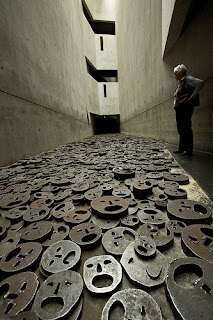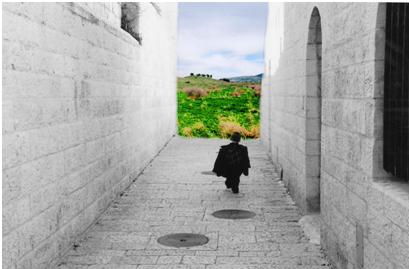Soon after we sat down opposite each other and stared out the window to avoid making eye contact, a young woman ascended onto the bus, baby carraige in tow. She lifted the baby out of the pushcart and sat down with him behind me.
First, I heard the cooing, and the mother whispering to her baby in English, "See? See the busses? See the babies and the mommies?" as they looked out the window. Then, I saw the face of the woman accross from me - her almond-shaped eyes sugared over like candy, and the wrinkles near her eyes shooting upwards like arrows pointing at her headscarf as she smiled a toothy grin. Soon, she was snapping, knocking on the window, and speaking what I can only assume was Hebrew baby-talk.
Others joined in. The whole front of the bus was watching the baby as it pretended to answer a cell phone and made loud noises to imitate car horns. We were stuck in traffic. We weren't moving at all. And rather than the tired, annoyed, silent bodies with sagging shoulders who can usually be found on the bus at this time, we were laughing, talking to each other, making funny faces, and smiling broadly.
------------------------------
Today in ulpan we heard a lecture about the symbolism of land/earth/dirt in Israeli art. Here's a bit of a summary. While land is an important universal topic in art, in Israel it holds particular social, political, and religious meaning. In the beginnings of art (ie. cave paintings) land wasn't itself a subject, but instead was a medium for the production of art - artists used blood and dirt in order to create representations of the world around them. In recent years, the French artist Jean Debuffet created paintings that were similar to cave paintings in order to highlite the connection between people and the earth. The lecturer noted the deep conection in the Hebrew language itself - Adam, meaning man (also the name of the first man in the Bible), and Adama, meaning dirt/earth/land. In the Bible, Adam is created out of the earth, and as Children of Adam, when we breath our last breath, we return to the earth once more. Many of Debuffet's paintings illustrate this concept, as they depict humans the color of earth, often using dirt as a material out of which to produce the work. In one painting in particular that the lecturer showed us, the human bodies are hidden amidst all the colors of the soil, and are so integrated into the material of the land that it is hard to see them - they are part and parcel of the soil itself. The lecturer said, and this seemed to be her main point throughout, that this art was about a universal concept, but that Israeli art tended to take these universal concepts and address them in Israel-specific ways.
In 1906, the Bezalel Acadamy of Art and Design, Israel's national school of art, was opened. Israeli art basically began at its opening, as the teachers created a new school of art, the Bezalel school, that combined European and Middle Eastern aesthetics and techniques.
From it's beginnings, Israeli art was preoccupied with the idea of land. Paintings represented Biblical Jews participating in festivals connected to agriculture, and pioneers working the land. Unline in many other times in Jewish (particularly European Jewish) history, when Jews were forbidden from owning and working land, in Israel Jews had the opportunity to reap and to sow, to plant and to eat what they had grown. It was strongly emphasized that the way to build the country was to work with the land.
To emphasize her point about the way that art represented connectedness to the land, our lecturer showed us a self portrait by Reuven Rubin, a famous Israeli artist from Romania, who painted himself with darker skin than he acutally had because it was the color of the ground and the color of people when they work in the sun in Isreal. In the painting he is also wearing slippers to demonstrate that he is a
 t home in the land, which dominates the painting. In others of Reuven's paintings, the horizen line is abnormally high at the top of the painting, so that the sky takes up just the tiniest uppermost space of the canvas (see the picture to the left of this text). The land, then, takes up almost the whole painting, and the paintings all contain the fruits of the land - bananas, oranges, and other warm-weather produce. We also saw a painting by Nachum Gutman of an orchard - a symbol of fruitfulness and prosperity. The lecturer showed several slides of popular images such as publicity posters and children's books that emphasized working the land. The images are full of warm colors and demonstrate the joys of agriculture.
t home in the land, which dominates the painting. In others of Reuven's paintings, the horizen line is abnormally high at the top of the painting, so that the sky takes up just the tiniest uppermost space of the canvas (see the picture to the left of this text). The land, then, takes up almost the whole painting, and the paintings all contain the fruits of the land - bananas, oranges, and other warm-weather produce. We also saw a painting by Nachum Gutman of an orchard - a symbol of fruitfulness and prosperity. The lecturer showed several slides of popular images such as publicity posters and children's books that emphasized working the land. The images are full of warm colors and demonstrate the joys of agriculture.The lecturer then went on to talk about other forms of art that were universal in other places and became Israel-specific when produced by Israeli artists. She described the earth works movement of the late 1960's and early 1970's in the US which used the earth itself as the canvas for art. She described the work of Robert Smithson, who is most well known for his earth work "Spiral Jetty." This was a giant, 450 meters in diameter, spiral on the beach fo Utah's Salt Lake. He created a work of art in place that could not be kept in a gallery or museum. The ideas of his art were what the lecturer described as "cosmopolitical" and universal. The lecturere also described the work of Michael Heiser, whose work "Double Negative," also an earth work in place, consists of two trenches accross a large gap. The trenches together measure 1,500 feet long, 50 feet deep, and 30 feet wide. 240,000 tons of rock was displaced in the construction of the trenches. The trenches demonstrate the ideas of positive and negative space - of having and lacking.
In Israel, artists adapted the ideas of the land art movement and used them to create art that addressed the specific issues and significance of land in Israel. Avital Geva, a commander wounded in the 1967, created a land art project in which he gathered a group of Arabs and Israelis from a kibbutz and a nearby Arab village and together with them dug two holes - one in the kibbutz and one in the villaige. They moved the dirt from one hole to the other, symbolically saying tha the land belongs to both people, and can be shared cooperatively, rather than being fought over.
We also learned about some Palestinan art, but unfortunately I didn't catch the name of the artist about which our lecturer spoke. She showed us two works that were sculpted out of dirt and sand. The first, "Hagar" was of a face of a beautiful woman. The land was cracked and dry, but she was nevertheless created and formed out of it - the mother earth of the Palestinian people. The second, "I am Ishmael" was of a man's body constructed out of dry, cracked, sand and dirt, surrounded by rocks.
The lecturer then sped through a number of artists whpose work indicates that unlike in the more idealistic mood of the past, the land is no longer just a symbol of fruitfulness and of arriving home. The land has also become a symbol of war and death, as disputes over land are the cause for much strife and pain in Israel. In particular, we looked at the work of Moshe Gershuni, who paints the land red, covered with blood.
We saw a slide of a sculpture of chocolate soldiers - who appeared brave and strong. We were dold that the artist invited people to eat the chocolate and after a while the sculpture which had once seemed brave and beautiful appeared deeply sad, as though the soldiers had been victims of a bombing - heads detached from limbs, flakes of bodies strewn about. And soon it all disappeared.
We saw a work
 by Menashe Kadishman called "Falling Leaves" which is on display in the Jewish Museum of Berlin. Piles and piles of metal circular faces with open mouths cover the floor between two walls. The artist encourages people to walk on the metal and hear the noise they make - those open mouths crying put from the ground. It is meant to symbolize those who perished and were buried in unmarked graves - that the ground we walk on contains so much pain.
by Menashe Kadishman called "Falling Leaves" which is on display in the Jewish Museum of Berlin. Piles and piles of metal circular faces with open mouths cover the floor between two walls. The artist encourages people to walk on the metal and hear the noise they make - those open mouths crying put from the ground. It is meant to symbolize those who perished and were buried in unmarked graves - that the ground we walk on contains so much pain.We also saw a slide of a work that is meant to look both like a backgammon board - to which there are two sides but they participate together in cooperation - and like the mouth of a sharp-toothed monster. The work, our lecturer told us, was strongly influenced by the work of Yoko Ono, who has created a number of pieces that are chess boards with both sets of peices white - so that it is impossible for them to make war.
The last artist we discussed was Erez Israeli. His work, a lawn with red poppies, constructed out of tiny beads, sits on the floor of the Givon Art Gallery in Tel Aviv. The po
 ppies are beautiful, but have mythological significance as the flowers that are said to grow in the places where heroes have fallen. Thus, in this represenation, the land is both beautiful and a place of death.
ppies are beautiful, but have mythological significance as the flowers that are said to grow in the places where heroes have fallen. Thus, in this represenation, the land is both beautiful and a place of death.The lecturer, whose speech was interesting if somewhat repetitive, concluded by saying that the land was a very powerful symbol in Israeli art. It has meanings of ownership and belonging, of being home, of work, of fruitfulness, of strength, but also of death, conflict, war, and pain.
In any case it was definatley an interesting lecture, particularly as before today I knew absolutely nothing whatsoever about Israeli art.

2 comments:
http://www.sfstation.com/made-in-palestine-at-somarts-gallery-a1195
Is any of this what you where talking about? (I tried researching the palestinian artist via google, but didnt find anything conclusive.)
-Megan/Ninja
Here we go, I found it. It's a mud relief, called "Hagar" (1996) by Silman Mansour. The only place I could find a picture of it was on the cover of this book:
http://books.google.com/books?id=0HFK0Q6njVEC
Post a Comment